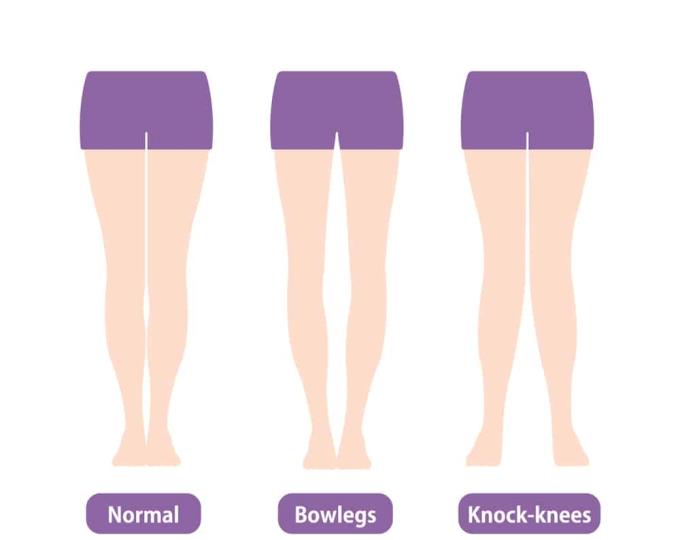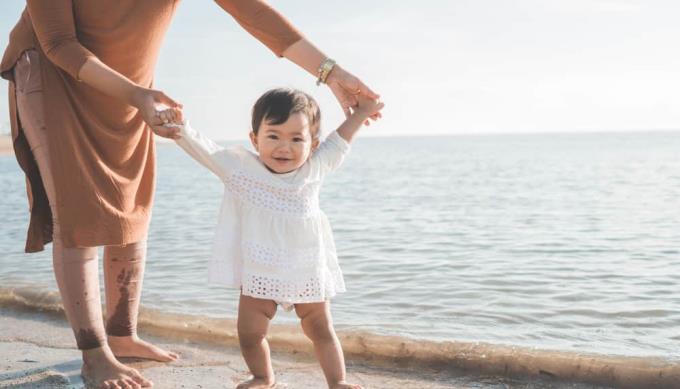Ways to determine an infants caloric needs

Learn how to determine your baby’s caloric needs, including the calories in breast milk and formula, to ensure your infant gets the right nutrition for healthy growth.
Imprisonment is not only unattractive when a child grows up, but also involves many other health problems. Because of that, parents need to better understand this situation to find the best solution for their children.
Type the keyword "bow tie legs" on a search engine, you will probably dazzle with hundreds of articles on this topic. Skimming through a few pages, you will be confused by too much relevant information, but the accuracy is not guaranteed.
Understanding that, aFamilyToday Health has gathered and sent readers the best knowledge about this defect, the basic knowledge and effective remedies.
Arched legs (also known as bent legs, O-shaped legs) are an unusual type of leg that is common to infants and children under 2 years of age. Accordingly, the knees will be facing apart, even when the ankles are close to each other, there is still a distance between the knees.
The way to check if your child has this condition is very simple, any parent can do it at home. First, put the baby in a supine position, with legs stretched out, two ankles touching each other. Then you measure the distance between the child's knees (at the bulging position in the femur). If the distance is less than 10cm, this means that the baby is still growing normally. In case, the measuring distance is more than 10cm, you should not be too worried, you need to take your baby to the hospital for further examination by the doctor.
In fact, the majority of cases of children with ankled legs develop well. This defect can be due to the wrong position of the fetus in the womb, as the baby gets older, the legs will return to normal without any impact. Parents also need to note that massage or manipulation of the legs is completely ineffective.

Many people mistakenly hold armpits as the cause of the bent leg in children. However, this is completely not true.
Anklet legs are divided into 2 categories: pathological anklet legs and pathological ankles. As mentioned above, the physiologically curved leg adjusts itself over time without any intervention (usually up to 2 years). While the legs are bent due to disease can be caused by the following reasons:
"Leggings genetic?" The answer is yes, if the parent has previously had a bent leg, the baby is also at risk. This is a genetic trait, so there is usually no cure. In terms of aesthetics, the family can take the baby to the orthopedic clinic for advice on corrective surgery for the baby. But it must wait for the baby to reach a certain age to intervene with this method.
Whether parents let their baby walk too early (before 7−9 months) or overweight are also risk factors for this type of malformation. When the baby is young, the skeletal system is still not strong enough to support the full body weight, so early walking, especially overweight children, will increase the risk of bent leg.
In addition, a number of medical conditions that can lead to O-shaped legs include: rickets due to prolonged vitamin D deficiency ; osteoporosis, also known as vitreous or brittle bones; dysplasia of cartilage (growth disorder that makes bones unable to develop) ... If parents find that the child has any abnormal manifestations, it is necessary to bring the baby to reputable medical facilities for appropriate examination and treatment. .
When observing that the baby has the phenomenon of bent legs, parents should perform the above examination to determine if the baby's legs are within normal limits or not. If the baby's legs develop in normal limits, parents can rest assured that their children can move while monitoring the baby's development as well as the progression of the legs. If the distance between the two pillows when measuring is greater than 10cm, parents can bring their baby to a large and reputable medical facility to be diagnosed with the cause and tracked progress every 3-6 months.
In order to help children overcome the situation of legs and knees, parents themselves must better understand the knowledge related to this issue. Accordingly, you can search for information about your baby's developmental milestones and physiological and pathological changes to clearly identify the disease you are experiencing in your child, thereby reducing the risk of changes. unpredictable.
While the hoop can improve over time, it's also important to know when to see your baby's doctor. For example:
When your baby is uncomfortable about moderate to severe pain (bowed legs usually don't cause pain)
Baby started limping
Only one leg is bound
The baby leg becomes more arched for a short time
Note when the legs in bowls begin to develop after children are 5-7 years old.

A healthy and nutritious diet will reduce the risk of developing bone problems like bone deformities as well as prevent the possibility of recurrence of inflammatory attacks that degrade joint cartilage. Calcium, vitamin D, minerals, proteins and vitamins are essential for the normal development of a child with a bow tie. You should study carefully the menus for children so that your child will both receive all the nutrients and not gain too much weight.
The way to overcome bow-legs in children is to have them wear braces at night. This is the form commonly used by pediatricians for early management of this malformation. Most types of anklet legs improve as the child gets older, but therapists recommend that you take your baby for multiple treatment with comprehensive methods to recover early.
Seeking physiotherapists such as massage therapists is also very helpful. Many experts believe that massage and manipulation of the legs for children may take a longer time, but if started at an early stage, this method will help reduce the curvature of the legs as the baby grows.
This is another comprehensive way to control a child's bowed legs. This exercise helps the muscles and soft connective tissues of the body reassemble structures. In addition, exercise also indirectly improves the strength of the body and restores correct posture (often changed in children with bow and legs). You can also try some of the following exercises to strengthen your baby's legs:
Exercise 1
Place your baby on his or her back on a flat surface to bring the legs together
Lift up 2 feet at the same time and do not separate them.
Exercise 2
Place your baby on his or her stomach, legs stretched and held in this position for a while. You can attract your baby's attention with colorful toys.
Let your baby lie on his back and place a toy around for him to practice rock. Choose toys that make a sound when your baby touches them. This will help your baby feel more excited.
Exercise 3
Put your baby on his stomach
Fold your legs over and slowly let your heels reach your buttocks
Repeat this movement 3 - 5 times.
You must be very careful and do not put pressure on your baby. These fun activities can help strengthen the muscles in your legs. Your baby will enjoy playing with you more.
Studies have shown that legs in bow often show that bones and connective tissue are subject to stress and stress due to uneven distribution and joints. Therefore, for children, being overweight will overload the baby's bones, resulting in deformation of the lower extremities. Parents absolutely should not let their baby gain excess weight by encouraging their children to practice healthy eating habits , limit snacking and promote normal physical activity.
In addition, obese children have a higher risk of joint damage that causes legs and legs. The risk is even higher if someone in the family has a bone disorder.
If the bow and leg condition is not corrected, the child may experience many complications such as arthritis, discomfort when walking, and bent knees. So, if you notice signs that your child has a bow tie or suspect that your child has this condition, you should take your child to the doctor.

To fix a bowel movement, an orthopedist or a physical therapist can:
Measure the distance between two spherical protrusions in the femur in the lying position, then let the baby stand and walk, and observe whether the deformation increases or not.
Find out about a family history of anyone with a bent leg, a history of patient with a lower limb fracture or any medical condition
Observe whether the bow deformation is symmetrical or not (both legs or only one bent leg): whether this bracelet deformation progresses in a worse direction
Check if the child is overweight or obese or the length of two legs is equal
If necessary, your child's doctor will have an X-ray to determine the angle of the leg deviation.
Hopefully this article gives you the necessary knowledge to better understand what the tripod phenomenon is, as well as its remedies.
You may be interested in the topic:
The risk of osteoarthritis caused by flat feet in adults
Table index of height, weight of the child and 6 factors determining stature
How to remove a splinter from a child's legs that mothers should know
Learn how to determine your baby’s caloric needs, including the calories in breast milk and formula, to ensure your infant gets the right nutrition for healthy growth.
Discover the top 5 smartest dog breeds in the world, including Border Collie, Poodle, German Shepherd, Golden Retriever, and Doberman Pinscher. Learn about their unique traits and why they are considered the most intelligent dogs.
Discover 7 nutritious and delicious ways to cook egg porridge for babies, including recipes with cheese, pumpkin, tomato, and more. Learn how to prepare baby-friendly egg porridge with our expert tips.
After a series of medical measures they obtained a complete human vascular system profile.
Watermelon is one of the fruits that many people love, not only cheap but also delicious, nutritious and refreshing in the summer. To get delicious watermelon pieces, show off your housewives, your artistic talents to cut beautiful pieces of watermelon.
aFamilyToday Health - The digestive system and body in each baby is different. Parents need to recognize notes to deal with when babies have a food allergy!
Babies need many factors for perfect development. aFamilyToday Health shares with parents things to keep in mind when babies are 8 weeks old so that parents can take care of their babies the best!
Babies need many factors for perfect development. aFamilyToday Health shares with parents things to keep in mind when babies are 18 weeks so that parents can take care of their babies the best!
Babies need many factors for perfect development. aFamilyToday Health shares with parents things to keep in mind when babies are 28 weeks old so that parents can take care of their babies the best!
Babies need many factors for perfect development. aFamilyToday Health shares with parents things to keep in mind when babies are 32 weeks old so that parents can take care of their babies the best!








